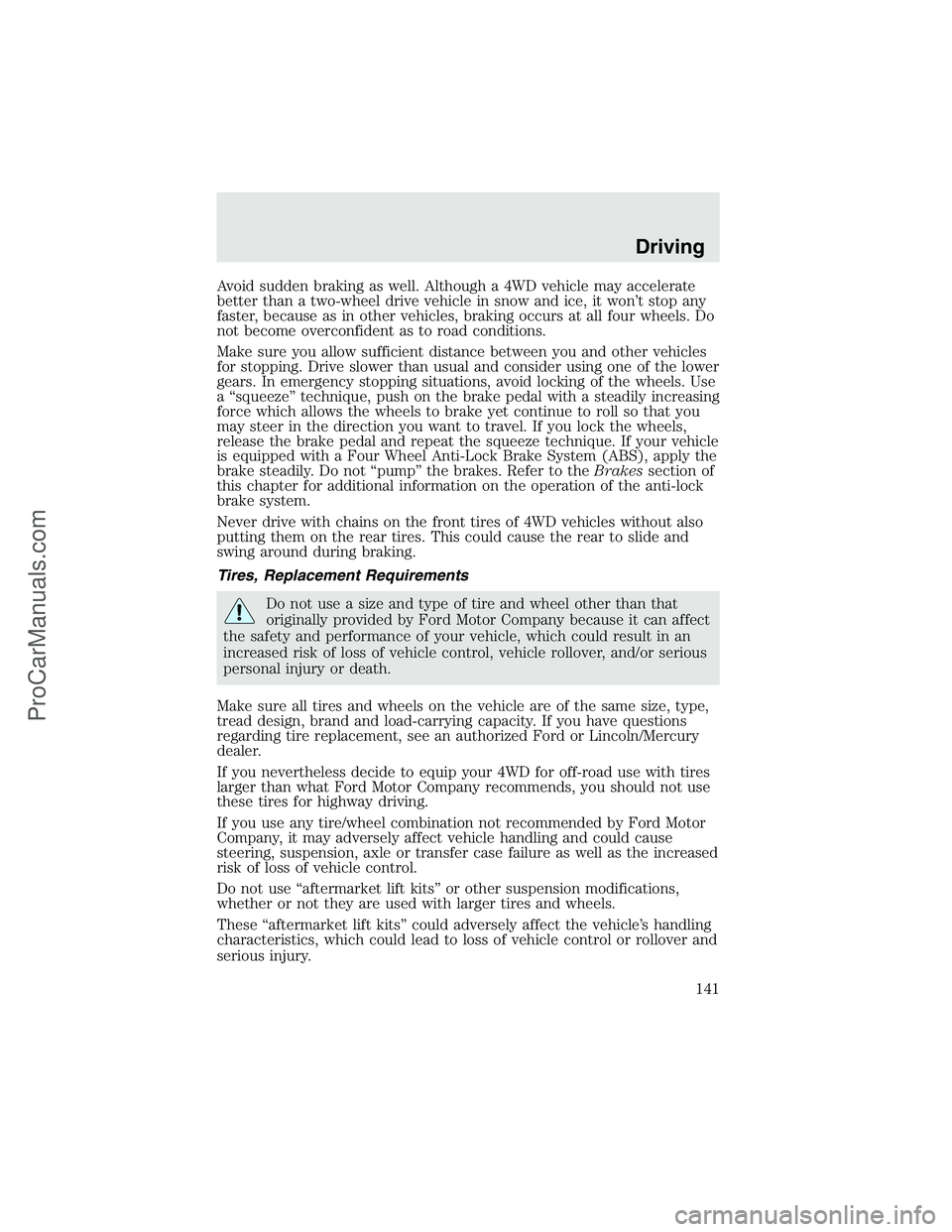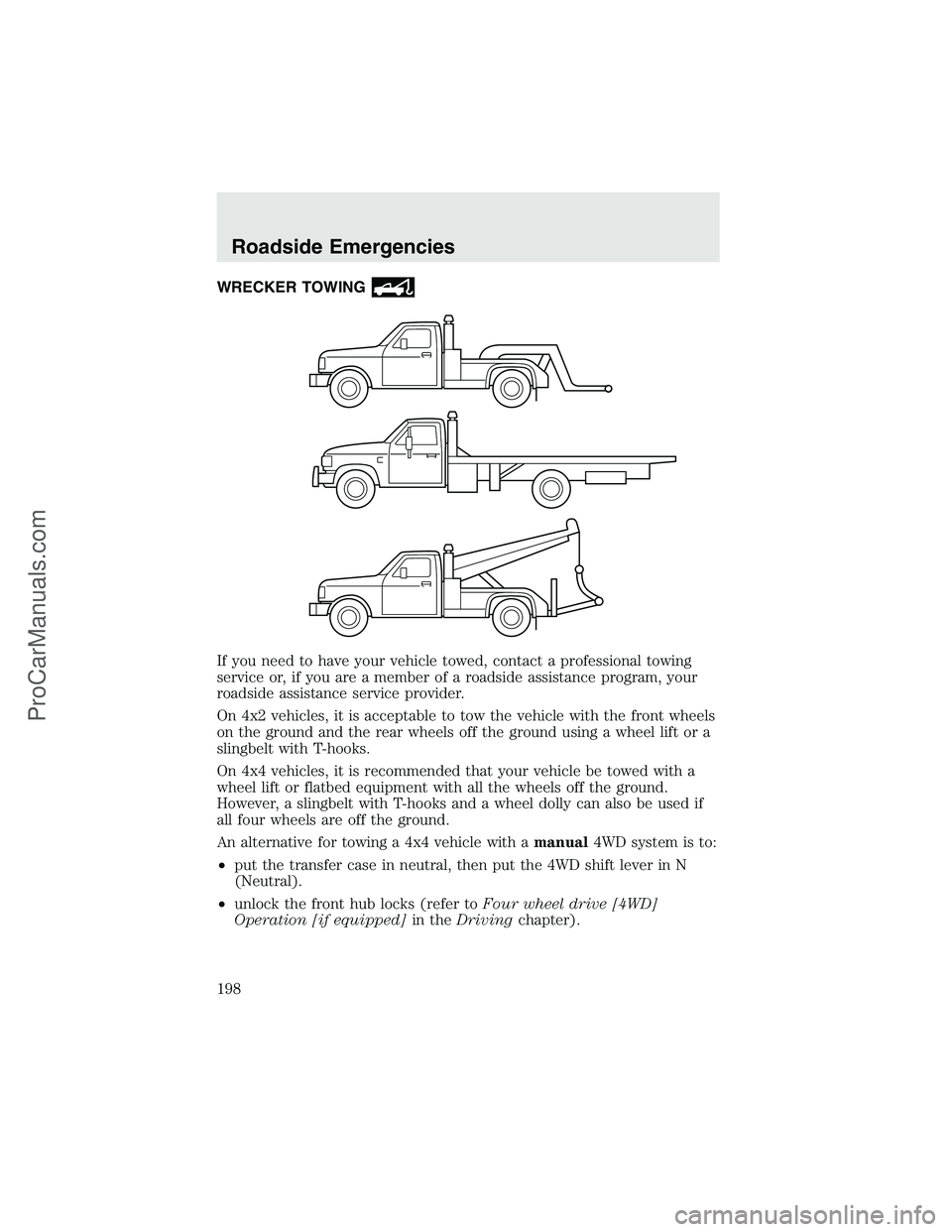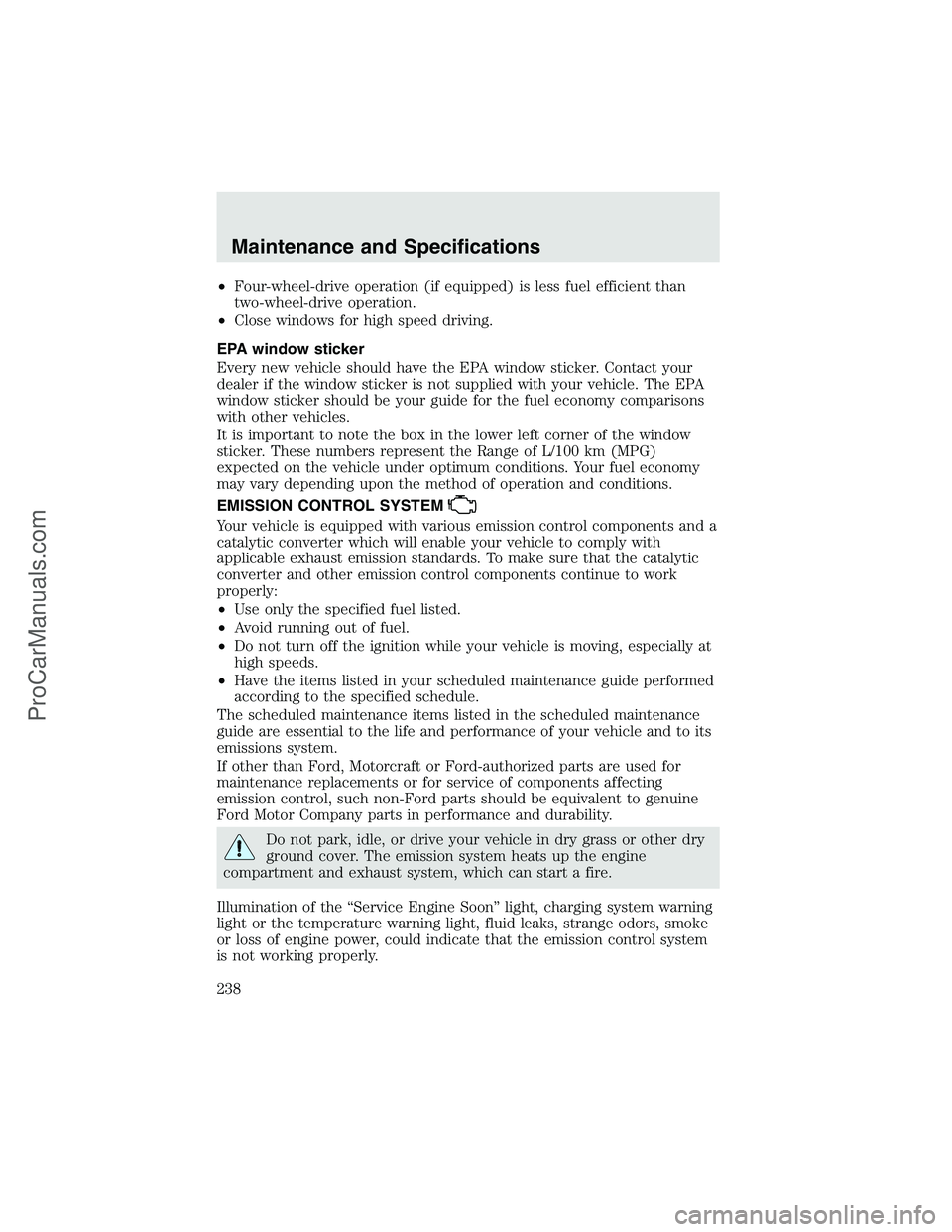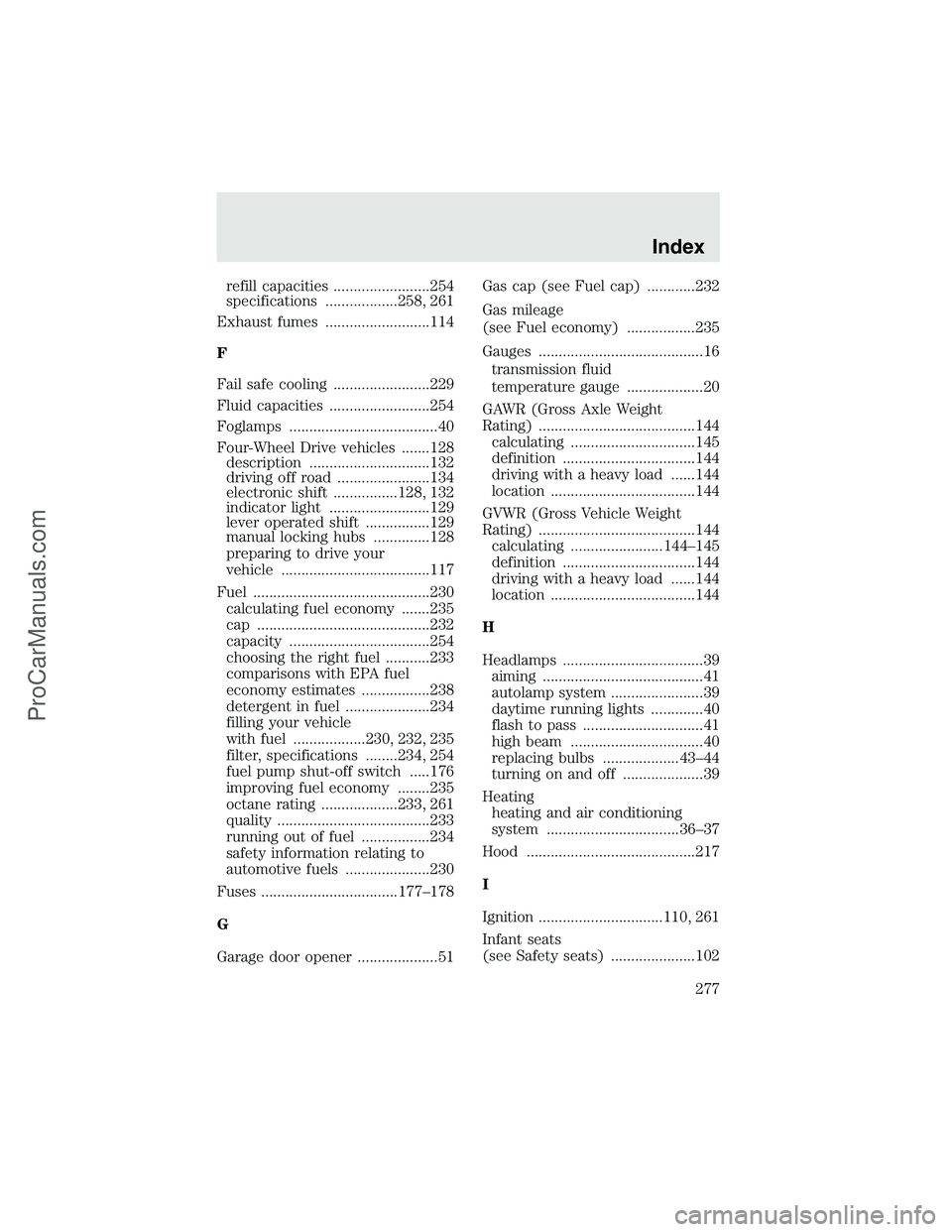2003 FORD F350 four wheel drive
[x] Cancel search: four wheel drivePage 141 of 280

Avoid sudden braking as well. Although a 4WD vehicle may accelerate
better than a two-wheel drive vehicle in snow and ice, it won’t stop any
faster, because as in other vehicles, braking occurs at all four wheels. Do
not become overconfident as to road conditions.
Make sure you allow sufficient distance between you and other vehicles
for stopping. Drive slower than usual and consider using one of the lower
gears. In emergency stopping situations, avoid locking of the wheels. Use
a“squeeze”technique, push on the brake pedal with a steadily increasing
force which allows the wheels to brake yet continue to roll so that you
may steer in the direction you want to travel. If you lock the wheels,
release the brake pedal and repeat the squeeze technique. If your vehicle
is equipped with a Four Wheel Anti-Lock Brake System (ABS), apply the
brake steadily. Do not“pump”the brakes. Refer to theBrakessection of
this chapter for additional information on the operation of the anti-lock
brake system.
Never drive with chains on the front tires of 4WD vehicles without also
putting them on the rear tires. This could cause the rear to slide and
swing around during braking.
Tires, Replacement Requirements
Do not use a size and type of tire and wheel other than that
originally provided by Ford Motor Company because it can affect
the safety and performance of your vehicle, which could result in an
increased risk of loss of vehicle control, vehicle rollover, and/or serious
personal injury or death.
Make sure all tires and wheels on the vehicle are of the same size, type,
tread design, brand and load-carrying capacity. If you have questions
regarding tire replacement, see an authorized Ford or Lincoln/Mercury
dealer.
If you nevertheless decide to equip your 4WD for off-road use with tires
larger than what Ford Motor Company recommends, you should not use
these tires for highway driving.
If you use any tire/wheel combination not recommended by Ford Motor
Company, it may adversely affect vehicle handling and could cause
steering, suspension, axle or transfer case failure as well as the increased
risk of loss of vehicle control.
Do not use“aftermarket lift kits”or other suspension modifications,
whether or not they are used with larger tires and wheels.
These“aftermarket lift kits”could adversely affect the vehicle’s handling
characteristics, which could lead to loss of vehicle control or rollover and
serious injury.
Driving
141
ProCarManuals.com
Page 198 of 280

WRECKER TOWING
If you need to have your vehicle towed, contact a professional towing
service or, if you are a member of a roadside assistance program, your
roadside assistance service provider.
On 4x2 vehicles, it is acceptable to tow the vehicle with the front wheels
on the ground and the rear wheels off the ground using a wheel lift or a
slingbelt with T-hooks.
On 4x4 vehicles, it is recommended that your vehicle be towed with a
wheel lift or flatbed equipment with all the wheels off the ground.
However, a slingbelt with T-hooks and a wheel dolly can also be used if
all four wheels are off the ground.
An alternative for towing a 4x4 vehicle with amanual4WD system is to:
•put the transfer case in neutral, then put the 4WD shift lever in N
(Neutral).
•unlock the front hub locks (refer toFour wheel drive [4WD]
Operation [if equipped]in theDrivingchapter).
Roadside Emergencies
198
ProCarManuals.com
Page 238 of 280

•Four-wheel-drive operation (if equipped) is less fuel efficient than
two-wheel-drive operation.
•Close windows for high speed driving.
EPA window sticker
Every new vehicle should have the EPA window sticker. Contact your
dealer if the window sticker is not supplied with your vehicle. The EPA
window sticker should be your guide for the fuel economy comparisons
with other vehicles.
It is important to note the box in the lower left corner of the window
sticker. These numbers represent the Range of L/100 km (MPG)
expected on the vehicle under optimum conditions. Your fuel economy
may vary depending upon the method of operation and conditions.
EMISSION CONTROL SYSTEM
Your vehicle is equipped with various emission control components and a
catalytic converter which will enable your vehicle to comply with
applicable exhaust emission standards. To make sure that the catalytic
converter and other emission control components continue to work
properly:
•Use only the specified fuel listed.
•Avoid running out of fuel.
•Do not turn off the ignition while your vehicle is moving, especially at
high speeds.
•Have the items listed in your scheduled maintenance guide performed
according to the specified schedule.
The scheduled maintenance items listed in the scheduled maintenance
guide are essential to the life and performance of your vehicle and to its
emissions system.
If other than Ford, Motorcraft or Ford-authorized parts are used for
maintenance replacements or for service of components affecting
emission control, such non-Ford parts should be equivalent to genuine
Ford Motor Company parts in performance and durability.
Do not park, idle, or drive your vehicle in dry grass or other dry
ground cover. The emission system heats up the engine
compartment and exhaust system, which can start a fire.
Illumination of the“Service Engine Soon”light, charging system warning
light or the temperature warning light, fluid leaks, strange odors, smoke
or loss of engine power, could indicate that the emission control system
is not working properly.
Maintenance and Specifications
238
ProCarManuals.com
Page 274 of 280

•Mobile communications systems may harm the operation of your
vehicle, particularly if they are not properly designed for automotive
use or are not properly installed. When operated, such systems may
cause the engine to stumble or stall or cause the transmission to be
damaged or operate improperly. In addition, such systems may be
damaged or their performance may be affected by operating your
vehicle. (Citizens band [CB] transceivers, garage door openers and
other transmitters with outputs of five watts or less will not ordinarily
affect your vehicle’s operation.)
•Ford cannot assume responsibility for any adverse effects or damage
that may result from the use of such equipment.
Vehicles with a higher center of gravity such as utility and
four-wheel drive vehicles handle differently than vehicles with a
lower center of gravity. Utility and four-wheel drive vehicles arenot
designed for cornering at speeds as high as passenger cars any more
than low-slung sports cars are designed to perform satisfactorily under
off-road conditions. Avoid sharp turns, excessive speed and abrupt
maneuvers in these vehicles. Failure to drive cautiously could result in
an increased risk of loss of vehicle control, vehicle rollover, personal
injury and death.
Accessories
274
ProCarManuals.com
Page 277 of 280

refill capacities ........................254
specifications ..................258, 261
Exhaust fumes ..........................114
F
Fail safe cooling ........................229
Fluid capacities .........................254
Foglamps .....................................40
Four-Wheel Drive vehicles .......128
description ..............................132
driving off road .......................134
electronic shift ................128, 132
indicator light .........................129
lever operated shift ................129
manual locking hubs ..............128
preparing to drive your
vehicle .....................................117
Fuel ............................................230
calculating fuel economy .......235
cap ...........................................232
capacity ...................................254
choosing the right fuel ...........233
comparisons with EPA fuel
economy estimates .................238
detergent in fuel .....................234
filling your vehicle
with fuel ..................230, 232, 235
filter, specifications ........234, 254
fuel pump shut-off switch .....176
improving fuel economy ........235
octane rating ...................233, 261
quality ......................................233
running out of fuel .................234
safety information relating to
automotive fuels .....................230
Fuses ..................................177–178
G
Garage door opener ....................51Gas cap (see Fuel cap) ............232
Gas mileage
(see Fuel economy) .................235
Gauges .........................................16
transmission fluid
temperature gauge ...................20
GAWR (Gross Axle Weight
Rating) .......................................144
calculating ...............................145
definition .................................144
driving with a heavy load ......144
location ....................................144
GVWR (Gross Vehicle Weight
Rating) .......................................144
calculating .......................144–145
definition .................................144
driving with a heavy load ......144
location ....................................144
H
Headlamps ...................................39
aiming ........................................41
autolamp system .......................39
daytime running lights .............40
flash to pass ..............................41
high beam .................................40
replacing bulbs ...................43–44
turning on and off ....................39
Heating
heating and air conditioning
system .................................36–37
Hood ..........................................217
I
Ignition ...............................110, 261
Infant seats
(see Safety seats) .....................102
Index
277
ProCarManuals.com
Page 279 of 280

Power distribution box
(see Fuses) ...............................178
Power door locks ..................65, 70
Power point .................................53
Power steering ..........................117
fluid, checking and adding ....240
fluid, refill capacity ................254
fluid, specifications .........258, 261
Power Windows ...........................53
Preparing to drive your
vehicle ........................................117
R
Radio ..........................20, 22, 25, 29
Relays ........................................177
Remote entry system .................67
illuminated entry ......................70
locking/unlocking doors ...........65
Reverse sensing system ...........126
Roadside assistance ..................175
S
Safety belts (see Safety
restraints) ........................77–81, 83
Safety defects, reporting ..........208
Safety restraints ....................77–83
belt minder ...............................85
cleaning the safety belts ..........89
extension assembly ..................89
for adults .............................78–81
for children ...............................99
lap belt ......................................84
warning light and chime ..........85
Safety seats for children ..........102
Seat belts (see Safety
restraints) ....................................77Seats ............................................72
child safety seats ....................102
cleaning ...................................213
Servicing your vehicle ..............216
Snowplowing .................8, 171–173
Spare tire
(see Changing the Tire) ...........182
Spark plugs,
specifications .....................254, 261
Special notice ................................9
ambulance conversions ..............8
diesel-powered vehicles .............8
four-wheel drive
vehicles ............................173–174
utility-type vehicles ....................8
Specification chart,
lubricants ...........................258, 261
Speed control ..............................57
Starting your
vehicle ........................110–111, 113
jump starting ..........................193
Steering wheel
tilting .........................................50
T
Tailgate ........................................64
Tires ...................................247–249
changing ..........................182, 185
checking the pressure ............249
replacing ..................................252
rotating ....................................250
snow tires and chains ............253
tire grades ...............................248
treadwear ................................248
Towing .......................................145
trailer towing ..........................145
wrecker ....................................198
Index
279
ProCarManuals.com